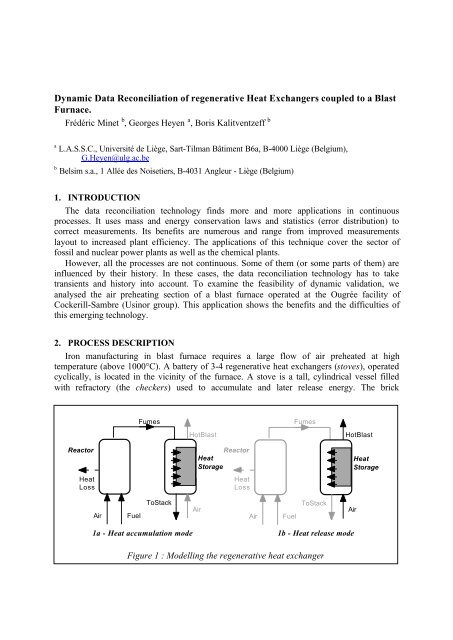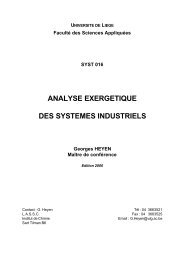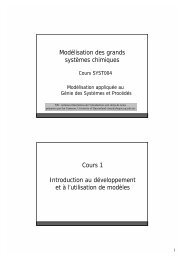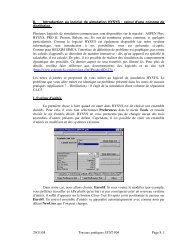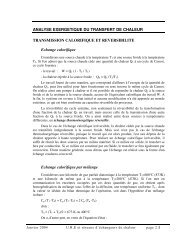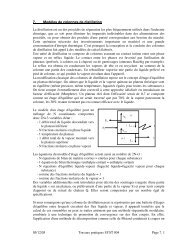Dynamic Data Reconciliation of regenerative Heat Exchangers ...
Dynamic Data Reconciliation of regenerative Heat Exchangers ...
Dynamic Data Reconciliation of regenerative Heat Exchangers ...
Create successful ePaper yourself
Turn your PDF publications into a flip-book with our unique Google optimized e-Paper software.
obtained in the previous step, and uses this model as a set <strong>of</strong> constraints to reconcile allavailable measurements.3. HEAT TRANSFER MODELWe assumed that the flow <strong>of</strong> gas through the <strong>regenerative</strong> heat exchanger is distributedevenly among the parallel channels (approximately 10000 <strong>of</strong> them). Thus the model willfocus on a single channel, and approximate the hexagonal cross section by an equivalentcircular section (figure 3). The partial differential equations describing the system will betransformed into ODE's by discretising the space co-ordinates.Assuming plug flow and no axial conduction in the gas leads to a dynamic balanceequation (Bird et al., 1960):⎡∂Tg∂Tg⎤ ∂P 4 hρgCpg , ⎢ + vg vg ( Tw Tg)t z⎥+ = −⎣ ∂ ∂ ⎦ ∂z Dh(1)Similarly for the tube wall:ρ∂T 1 ∂ ⎛ ∂T ⎞ ∂ T− − = 0∂t r ∂r ⎜r⎟⎝ ∂ ⎠ ∂z2s s ssCps ,rk ks2In order to obtain a numerical solution <strong>of</strong> this equation system, we discretised the solid andthe gas into cells <strong>of</strong> constant geometric and physical properties, each cell being approximately1 meter long. In the radial direction, the solid was also discretised into layers approximately 1mm thick (figure 3) exchanging heat by conduction with the neighbouring layers. Bysymmetry <strong>of</strong> the system, no heat is transferred from one channel to the adjacent one, so thedeepest layer only exchanges heat on one side. An overall heat loss term was added to the gasbalance equation to account for exchange with the ambient.The characteristic time for heat transfer in the radial direction was found to be in the order<strong>of</strong> one minute; this is the same order <strong>of</strong> magnitude as the phenomena to be monitored in theprocess, and therefore it may not be ignored. The temperature gradient in the solid in theradial direction can be as high as 1000 K/m, while it is approximately 30 K/m in the axialdirection. This is why we neglected the conductive heat transfer in the axial direction.The numerical solution <strong>of</strong> system dynamic equations was obtained by discretising alongthe space co-ordinates, and integration using Euler's method to find the variation <strong>of</strong> thetemperature field with time. The integration time step is limited to avoid numerical instability.In order to do so, the equations were rewritten as follows.Gas-solid transfer for a cellOn the gas side, an energy balance allows to calculate the heat transfer in a cell:Hout − Hin =−Qexch− Losses(3)where : H in : inlet gas enthalpyH out : outlet gas enthalpy, (H out = H in <strong>of</strong> the next layer)Q exch : heat transferred from the gas to the refractory brickworkThe average gas temperature <strong>of</strong> the layer can be obtained from the heat transfer equation:Tg( Hout-Hin-Losses)= + Tw(4)h.S(2)
The application <strong>of</strong> dynamic data reconciliation to the stove system allowed detecting someprocess malfunctions:• Some sensors do not measure what they are expected to do; this is the case for the dometemperature measurement using a pyrometer; the probe is supposed to measure the bricktemperature, but it is influenced by the emissivity <strong>of</strong> the gas through which it is aimed.Since the gas emissivity depends mainly from the partial pressure <strong>of</strong> CO 2 and H 2 O, thebias introduced is not the same when the unit operates on-gas or on-blast.• Some sensors are not appropriate (the oxygen probe saturates when the blast is enrichedwith oxygen).• Some sensors are not ideally located : e.g. the thermocouples located below the supportinggrid do not provide an adequate estimate <strong>of</strong> the brick temperature when the regeneratoroperates on blast; in fact the thermocouple is surrounded with cold air, and measures thegas temperature more than the solid temperature.• Some measured values were not correctly converted in the process computer, such as thelower heating value for the residual gas used as a fuel.5. CONCLUSIONThe main goal <strong>of</strong> the present study was to better understand the behaviour <strong>of</strong> the<strong>regenerative</strong> heat exchanger, in order to improve its control . The model developed allows tocarry out a sensitivity analysis and to validate the measurement system.It provided also values <strong>of</strong> key operating parameters <strong>of</strong> the plant, which are needed foroptimally scheduling <strong>of</strong> the energy accumulation and delivery. By operating closer to theoperating limits and decreasing the heat losses, significant fuel savings are expected (in arecent paper, Muske and al.(2000) developed a similar model as a support for optimal controland they report savings in the range <strong>of</strong> 5%).This study shows the feasibility and the possibilities <strong>of</strong> dynamic validation but it alsoidentifies some practical limitations: selection <strong>of</strong> initial conditions, inertia phenomenon,...6. SYMBOLSC p specific heatD h hydraulic diameter <strong>of</strong>a channelh heat transfercoefficientk thermal conductivityP pressurerSTvzρradial co-ordinategas-solid exchangearea in a celltemperaturegas velocityaxial co-ordinatespecific gravitySubscriptsg gass solidw gas-solid interface7. REFERENCESBird R.B., Stewart W.E., Lightfoot E.N., Transport Phenomena, Wiley New York (1960)BELSIM, VALI III Users Guide, BELSIM s.a., Allée des Noisetiers 1, 4031 Angleur (Belgium) (1999)Cameron D, Fault Detection and Diagnosis, in "Model Based Manufacturing - Consolidated Review<strong>of</strong> Research and Applications", document available in CAPE.NET web site(http://capenet.chemeng.ucl.ac.uk/ ) (1999)Muske K.R., Howse J.W., Hansen G.A., Cagliostro D.J, Model-based control <strong>of</strong> a thermalregenerator: Part 1 : dynamic model, Computers & Chemical Engineering 24, 2519-2531 (2000)Part 2 : Control and estimation, Computers & Chemical Engineering 24, 2507-2518 (2000)


